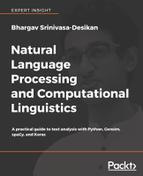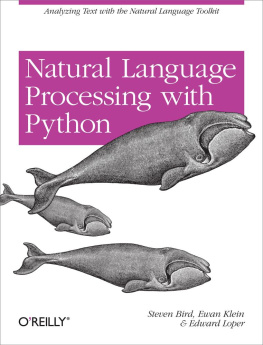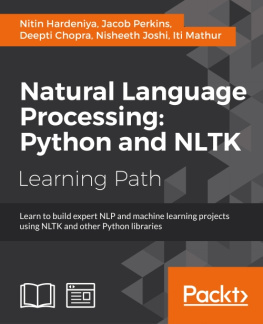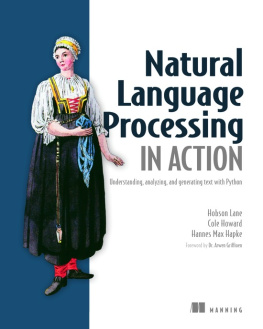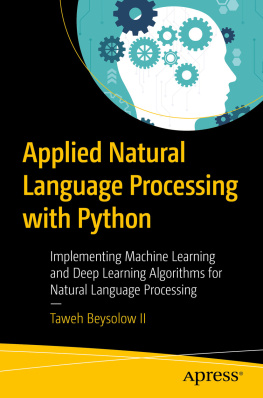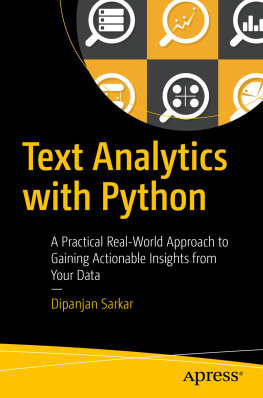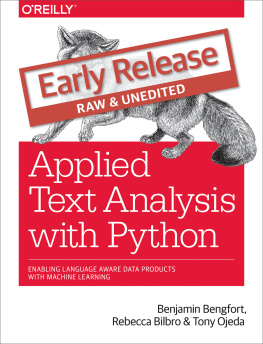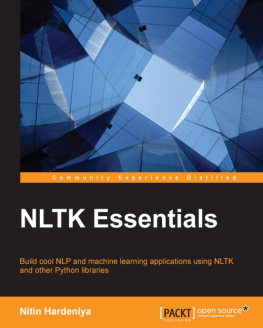Bhargav Srinivasa-Desikan [Bhargav Srinivasa-Desikan] - Natural Language Processing and Computational Linguistics: A Practical Guide to Text Analysis With Python, Gensim, spaCy, and Keras
Here you can read online Bhargav Srinivasa-Desikan [Bhargav Srinivasa-Desikan] - Natural Language Processing and Computational Linguistics: A Practical Guide to Text Analysis With Python, Gensim, spaCy, and Keras full text of the book (entire story) in english for free. Download pdf and epub, get meaning, cover and reviews about this ebook. year: 2018, publisher: Packt Publishing, genre: Home and family. Description of the work, (preface) as well as reviews are available. Best literature library LitArk.com created for fans of good reading and offers a wide selection of genres:
Romance novel
Science fiction
Adventure
Detective
Science
History
Home and family
Prose
Art
Politics
Computer
Non-fiction
Religion
Business
Children
Humor
Choose a favorite category and find really read worthwhile books. Enjoy immersion in the world of imagination, feel the emotions of the characters or learn something new for yourself, make an fascinating discovery.
- Book:Natural Language Processing and Computational Linguistics: A Practical Guide to Text Analysis With Python, Gensim, spaCy, and Keras
- Author:
- Publisher:Packt Publishing
- Genre:
- Year:2018
- Rating:4 / 5
- Favourites:Add to favourites
- Your mark:
Natural Language Processing and Computational Linguistics: A Practical Guide to Text Analysis With Python, Gensim, spaCy, and Keras: summary, description and annotation
We offer to read an annotation, description, summary or preface (depends on what the author of the book "Natural Language Processing and Computational Linguistics: A Practical Guide to Text Analysis With Python, Gensim, spaCy, and Keras" wrote himself). If you haven't found the necessary information about the book — write in the comments, we will try to find it.
Work with Python and powerful open source tools such as Gensim and spaCy to perform modern text analysis, natural language processing, and computational linguistics algorithms.
Key Features- Discover the open source Python text analysis ecosystem, using spaCy, Gensim, scikit-learn, and Keras
- Hands-on text analysis with Python, featuring natural language processing and computational linguistics algorithms
- Learn deep learning techniques for text analysis
Modern text analysis is now very accessible using Python and open source tools, so discover how you can now perform modern text analysis in this era of textual data.
This book shows you how to use natural language processing, and computational linguistics algorithms, to make inferences and gain insights about data you have. These algorithms are based on statistical machine learning and artificial intelligence techniques. The tools to work with these algorithms are available to you right now - with Python, and tools like Gensim and spaCy.
Youll start by learning about data cleaning, and then how to perform computational linguistics from first concepts. Youre then ready to explore the more sophisticated areas of statistical NLP and deep learning using Python, with realistic language and text samples. Youll learn to tag, parse, and model text using the best tools. Youll gain hands-on knowledge of the best frameworks to use, and youll know when to choose a tool like Gensim for topic models, and when to work with Keras for deep learning.
This book balances theory and practical hands-on examples, so you can learn about and conduct your own natural language processing projects and computational linguistics. Youll discover the rich ecosystem of Python tools you have available to conduct NLP - and enter the interesting world of modern text analysis.
What you will learn- Why text analysis is important in our modern age
- Understand NLP terminology and get to know the Python tools and datasets
- Learn how to pre-process and clean textual data
- Convert textual data into vector space representations
- Using spaCy to process text
- Train your own NLP models for computational linguistics
- Use statistical learning and Topic Modeling algorithms for text, using Gensim and scikit-learn
- Employ deep learning techniques for text analysis using Keras
This book is for you if you want to dive in, hands-first, into the interesting world of text analysis and NLP, and youre ready to work with the rich Python ecosystem of tools and datasets waiting for you!
Table of Contents- What is Text Analysis?
- Python Tips for Text Analysis
- spaCys Language Models
- Gensim Vectorizing text and transformations and n-grams
- POS-Tagging and its Applications
- NER-Tagging and its Applications
- Dependency Parsing
- Top Models
- Advanced Topic Modelling
- Clustering and Classifying Text
- Similarity Queries and Summarization
- Word2Vec, Doc2Vec and Gensim
- Deep Learning for text
- Keras and spaCy for Deep Learning
- Sentiment Analysis and ChatBots
**
About the AuthorBhargav Srivinasa-Desikan is a student researcher working for INRIA in Lille, France. He is part of the MODAL (Models of Data Analysis and Learning) team, and he works on metric learning, predictor aggregation and data visualization. He also contributes to open source machine learning projects, particularly dynamic topic models for Gensim.
Bhargav Srinivasa-Desikan [Bhargav Srinivasa-Desikan]: author's other books
Who wrote Natural Language Processing and Computational Linguistics: A Practical Guide to Text Analysis With Python, Gensim, spaCy, and Keras? Find out the surname, the name of the author of the book and a list of all author's works by series.

![Bhargav Srinivasa-Desikan [Bhargav Srinivasa-Desikan] Natural Language Processing and Computational Linguistics: A Practical Guide to Text Analysis With Python, Gensim, spaCy, and Keras](/uploads/posts/book/119021/thumbs/bhargav-srinivasa-desikan-bhargav.jpg)

